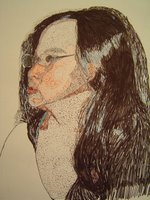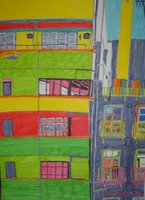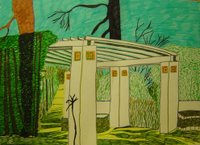This is what he had to say:
I think that your two self-portraits using pen and ink are the two most interesting drawings here.

 It is their uncertainty that I like, they seem to me to have an intense engagement with the subject, a searching for the self in external appearances, that is perhaps most evident in self-portraiture.
It is their uncertainty that I like, they seem to me to have an intense engagement with the subject, a searching for the self in external appearances, that is perhaps most evident in self-portraiture.I can see why you like your other work more, it is easier, it is less revealing, it risks less.
(Note: he's referring to my Seville Townscape, and to set the record straight, I didn't say I liked it more, I said I found the townscape project more inspiring than doing the park drawing (see bottom), and that I found working with pen and ink for the self-portraits a lot more difficult, which is not the same as saying I liked this drawing more).

This work seems to me to be very stylised in a way that I would describe as decorative. It has a strong emphasis on surface, pattern and an inventive, and largely subjective, use of colour.
To what extent is this decorative style determined by the limitations of the media you are working with?
(Note: I hadn't thought about that, but he's right, it was entirely affected by the fact that I was using marker pens. If it been a pastel drawing, I would have stuck to the original colours of the actual scene. I don't know if it would have made a more revealing drawing though.)
To what extent do you consider it to be your own?
(I don't even know what my style is, I say more on this below. However, I wasn't aware of trying to copy any particular style as I was drawing this.)
It is a style that reminds me of the work of David Hockney, Henry Matisse, Friedensreich Hundertwasser and Gustave Klimt, among others. These are all artists you will probably enjoy looking at if you are not already familiar with them. However this decadent enjoyment of surface is only one aspect of art and leaves much unexamined.
My overall response: Huh? Has my drawing just been dissed? Even so, I guess I'm in good company! Joking aside, I think I know what he means, but it's a little above my head, and very far in the future in terms of my development. I have no idea what my own style is, and part of me doesn't even like the idea of having a style that is so predictable it can be called mine, as if it would be something fixed and never change. Also, I really have no idea how to go about going beyond the surface as he says. All that I try to do with any drawing I attempt is to interpret as accurately as possible what I am looking at, on paper. I don't go beyond that just now, and I don't think about how to make it Art with a capital A, or a certain type of Art. This is what happened when I was writing and I got so hung up about producing work that was going to "wow" people, and therefore had to be whatever was "wow" or trendy at that time, that I lost any sense of why I was writing in the first place. It stopped being about my own process and became a way of trying to please other people. Yes, I do want to be challenged, I do want to learn, but I don't want to start thinking that I need to be changing my work to make it into something particular, whatever that may be, as I fear that may inhibit the process I'm already going through naturally in my development. Does this make sense? Have other artists out there experienced a similar process? Any thoughts out there by anyone would be most appreciated.
He goes on to say: I like the way you have used an olive green in your drawing of a park against a yellow to represent light and shadow.
 I like the way that you are beginning to think of colour tonally here and consider them not on their own but in relation to one another. For me this begins to open up the possibility of a more sensitive way of working with colour. It seems that with the introduction of this olive green against the yellow there is the beginning of a more spatial awareness of colour, using colour to represent light and to describe form and space in the way that Paul Cezanne or (early) Matisse might use colour.
I like the way that you are beginning to think of colour tonally here and consider them not on their own but in relation to one another. For me this begins to open up the possibility of a more sensitive way of working with colour. It seems that with the introduction of this olive green against the yellow there is the beginning of a more spatial awareness of colour, using colour to represent light and to describe form and space in the way that Paul Cezanne or (early) Matisse might use colour.My response: I didn't know I was doing that, is it helpful to have it pointed out? Not sure yet. Will it create an expectation and influence the way I work in future, in a positive way? Don't know. I guess we'll just have to wait and see how things develop. 4.4.06
* * * * * * * * *New bit...added 9th April, 2006 * * * * * * * *
For those of you who might be interested, I wrote back to my tutor asking for clarification on his comments, cos they just kind of confused me. I also explained that all I'm trying to do and feel able to do right now is to translate as accurately as possible what I see onto paper, and that although I know there is something more to work towards, I wasn't quite ready or even able to articulate yet what that might be. Here is his reply.
"For me, while attempting to “ translate what I can see before me as accurately as I can” (as you put it) is a useful skill in drawing, that “something more” that you speak of is where drawing becomes art. While we could talk about what this something more is endlessly I would suggest that this is perhaps the job of the philosopher and not the artist, and the best way we can find it as artists is through the practice of drawing itself. And without first having something, such as translating what you can see before you as accurately as you can, it is impossible to have something more.
In my comments I suggested two practical things that you can do to inform your practice. Firstly looking at the work of other artists. In doing this I have classified two kinds of artists, the “decorative” ones that deal with surface and those that deal with depth and form. You may or may not agree with this classification. My opinion is that this second way, that which deals with depth and form, is a good way forward for you because I think it will help you more to translate what you can see before you as accurately as you can.
Secondly I have given you a practical way of achieving this by using an example in your work (the olive green and yellow). I am suggesting a more tonal use of colour and you can see this in the work of the artists I have suggested. If you are interested you can read Johannes Itten's The Elements of Colour and Jack D Flam's Matisse on Art both of which will describe this in more depth. Basically try to think about a colour not as an isolated thing by itself but in terms of the relationship between it and other colours.
Drawing can be very confusing if you think about it too much, the best thing is to just get on with it and then it will become clearer through doing it."
I thought this was much clearer and told him so. However, my brain is buzzing and overflowing after thinking about all of this. Will try to calm down and just carry on drawing. In the meantime, I hope that some space clears up in my head eventually so I can take this new information in. I am quite excited about looking at the work of Matisse and Cezanne too. Will keep you posted. 9.4.06
12 comments:
Wow, what a great introspective post! There you go, you have made someone go "Wow"!
Joking apart - I did enjoy your Art and accompanying writing.
Wow Tammy. Now I understand why you left the comment you did on my blog. Great discussion, and I would be happy to discuss it more with you. Might be easier via email if that works for you. Mine is willie@groupbaronet.com
Bottom line on all of this is that all of art criticism is subjective, and often those with the best use of the language seem to be the authorities. Key word there is "seem". :-)
Hi
I just read your query on my site about style.
I couldn't find an email address so I'll try to reply tomorrow in this comments thread. cuz its too late tonight.
I really enjoyed reading your commentary
I like the second self-portrait a lot. There's something really compelling about it. Nice Blog, by the way. I myself, spent a lot of energy searching for my "style" or my "voice" as an artist. I think that although I'm still far from finding it, if I just keep drawing [a lot!] and focusing on subject matter that interests me as well as studying other artists' art that inspires me, that a little something of myself has begun to show in the work I create. I also think verbalizing your strengths and weaknesses is a great help in sorting out your artistic goals. Just remember to contrast where you were skillwise when you began with where your abilities are now and give yourself kudos for the progress you've made. Informed milage or constant education and practice will make all the difference on your journey. Best of luck to you!
I think every once and a while you draw something that, for some reason, you look at it and you like it. Something in it says to you that you're on to something. You might not even be able to verbalize it, but you'll know it when you see it. At that point, it's very important to hold on to that opinion, no matter what anyone else says.
Thank you both, mackaydesign & matt, makes total sense. Thanks for taking the time to reply too.
Hey, Tammy. It's excruciating to have someone dissecting your work critically, isn't it. It helps, though. I mean, this guy really made you think, huh! You asked how I developed my own style, whether or not it was conscious. Since it grew from the fine and respected art of doodling, I'd say--not so conscious. Keep drawing and painting what you love!
Very good advice Roz, thanks.
Very interesting to see two different takes on a self portrait side by side. You are very inventive and creative!
Why try to box yourself in with a particular style, restricted parameters. Wheres the fun.
Go with the flow, after all who are you trying to please.
I know this may sound odd from a cartoonist, but styles will develop naturally without you thinking about it, they will also change naturally over time with even less thought.
You find you go with what feels right & comfortable at the time.
This is very comforting Sim, and rather convenient as I can't imagine doing anything about it but just getting on with it.
Post a Comment